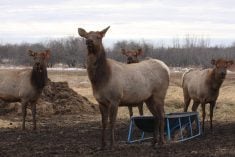FORT ST JOHN, B.C. – Bill Bouffioux is a bit flustered this morning. A
day earlier he’d forgotten to lock a gate and his bison got out of the
corral.
The bison didn’t wander far, but it took time on a cold winter day to
separate the animals and draw them back into the corral.
“It’s just about impossible to herd them in. You have to lure them
back,” he said.
“If everything goes OK, it’s easy. They see an open gate and they’re
Read Also

Canadian Food Inspection Agency extends chronic wasting disease control program consultation deadline
Date extended for consultation period of changes to CWD program
through. If everything gets excited, they get scared.”
But Bouffioux was in a hurry.
He had an appointment to deliver eight bison to a slaughter plant in
Dawson Creek, B.C., an hour’s drive away.
When he finally got his animals in the corral to check their herd ear
tag and Canadian Cattle Identification Association ear tag numbers, he
didn’t have paper handy to write the numbers down.
He ended up writing on the back of his leather gloves.
“It was the only thing I had handy,” he said with a laugh.
Last year, Bouffioux sold meat from 15 bison to neighbours and friends.
This year, he hopes to sell 30 bison through direct customer sales. But
the president of the Canadian Bison Association isn’t sure he and other
producers are doing the right thing for the industry by creating local
markets.
A company must be guaranteed a steady supply of bison before it will
invest millions of dollars in a specialized processing plant.
The more Bouffioux sells his bison to local customers, the longer it
will take to build a guaranteed meat supply.
“As long as we keep doing farm-gate sales we’re going to be a cottage
industry.”
Selling directly to customers is profitable, earning Bouffioux $1.25 a
pound more than the $1.40 to $1.60 a lb. a meat processor would pay.
However, he would prefer to sell to the processors, also known as
purveyors, who handle all the sales and marketing.
“I like the purveyor system because you take them there and they’re
done.”
But until one is established, he feels he has little choice but to
continue selling meat on his own.
Last year, his wife Fay opened a mobile concession booth, Buffalo
Girls, to sell bison at local fairs and shows, rodeos and auctions in
an effort to sell more bison meat.
The local air show association, unfamiliar with bison meat, was
reluctant to let her be one of the few concession booths on the grounds
during the air show, she said. Fay had to do some fast talking to get
her concession on the grounds.
“They were worried if it wasn’t good it would be a mark against the
association.”
But her fresh bison wieners, jerky, hamburgers and curly fries were a
hit with visitors and she’s likely guaranteed a spot for next year.














